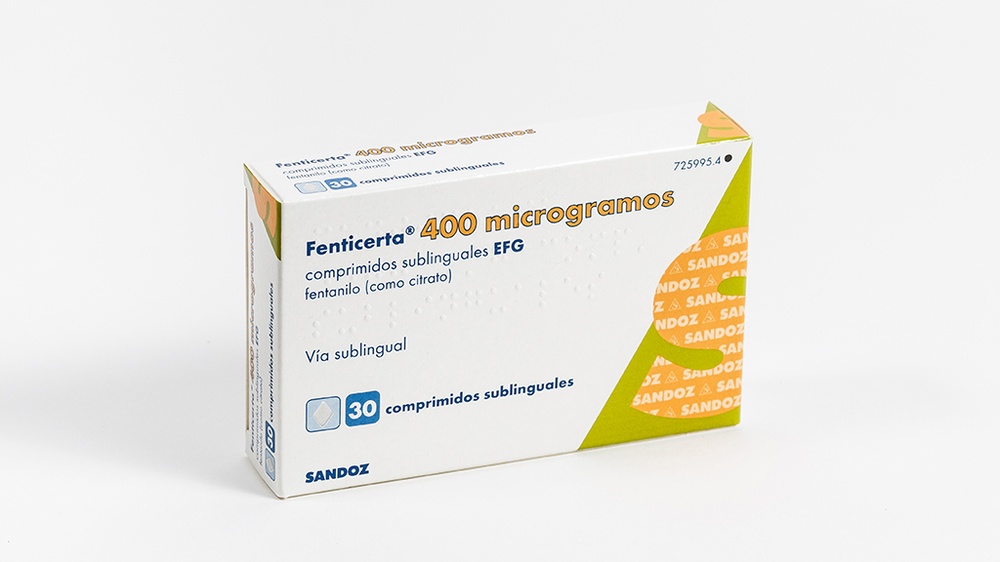

ФЕНТИЦЕРТА 400 мікрограмів ПІД'ЯЗИКОВІ ТАБЛЕТКИ

Запитайте лікаря про рецепт на ФЕНТИЦЕРТА 400 мікрограмів ПІД'ЯЗИКОВІ ТАБЛЕТКИ

Інструкція із застосування ФЕНТИЦЕРТА 400 мікрограмів ПІД'ЯЗИКОВІ ТАБЛЕТКИ
Введення
Опис: Інформація для користувача
Фентіцерта®100 мкг сублінгвальні таблетки ЕФГ
Фентіцерта®200 мкг сублінгвальні таблетки ЕФГ
Фентіцерта®300 мкг сублінгвальні таблетки ЕФГ
Фентіцерта®400 мкг сублінгвальні таблетки ЕФГ
Фентіцерта®600 мкг сублінгвальні таблетки ЕФГ
Фентіцерта®800 мкг сублінгвальні таблетки ЕФГ
фентаніл (у вигляді цитрату)
Прочитайте уважно весь опис перед тим, як почнете приймати цей препарат, оскільки він містить важливу інформацію для вас.
- Збережіть цей опис, оскільки вам може знадобитися знову його прочитати.
- Якщо у вас виникли питання, проконсультуйтеся з вашим лікарем або фармацевтом.
- Цей препарат призначений тільки для вас, і не слід давати його іншим людям, навіть якщо вони мають такі самі симптоми, як у вас, оскільки це може їм нашкодити.
- Якщо ви відчуваєте побічні ефекти, проконсультуйтеся з вашим лікарем або фармацевтом, навіть якщо це побічні ефекти, які не вказані в цьому описі. Див. розділ 4.
Зміст опису:
- Що таке Фентіцерта і для чого вона використовується
- Що потрібно знати перед тим, як почати приймати Фентіцерту
- Як приймати Фентіцерту
- Можливі побічні ефекти
- Збереження Фентіцерти
- Зміст упаковки та додаткова інформація
1. Що таке Фентаніл Фентіцерта і для чого вона використовується
Фентіцерта - це лікування для дорослих тієї особи, яка вже регулярно приймає потужні обезбольні засоби (опіоїди)для її постійного болю через рак, але потребує лікування від болю, який раптово виник. Якщо ви не впевнені, проконсультуйтеся з вашим лікарем.
Болю, який раптово виник, - це тип болю, який з'являється раптово, навіть якщо ви прийняли або використали ваш звичайний опіоїдний засіб для вашого болю.
Активна речовина Фентіцерти - фентаніл. Фентаніл належить до групи потужних обезбольних засобів, які називаються опіоїдами.
2. Що потрібно знати перед тим, як почати приймати Фентіцерту
Не приймайте Фентіцерту:
- якщо ви алергічні на активну речовину або на будь-яку іншу складову частину цього препарату (перелічені в розділі 6),
- якщо у вас є серйозні проблеми з диханням,
- якщо ви не використовуєте регулярно опіоїдний засіб, призначений вашим лікарем (наприклад, кодеїн, фентаніл, гідроморфон, морфін, оксикодон, меперидин), щодня о同じ час, протягом щонайменше тижня, для контролю постійного болю. Якщо ви не використовували ці засоби, не приймайтефентаніл сублінгвальні таблетки, оскільки їхнє використання може збільшити ризик того, що ваше дихання стане повільнішим і/або менш глибоким, і навіть зупиниться,
- якщо ви страждаєте на короткочасний біль, який відрізняється від болю, який раптово виник.
Попередження та застереження
Збережіть цей препарат у безпечному місці, захищеному від доступу інших осіб (див. розділ 5 «Збереження Фентіцерти», для отримання додаткової інформації).
Проконсультуйтеся з вашим лікарем або фармацевтом або медсестрою перед тим, як почати приймати Фентіцерту, якщо у вас є або були будь-які з наступних симптомів, оскільки ваш лікар потребуватиме цього при призначенні вашої дози:
- Травма голови, оскільки Фентіцерта може маскувати ступінь ушкодження
- Проблеми з диханням або міастенія важкого ступеня (стан, характеризований м'язовою слабкістю)
- Якщо у вас є проблеми з серцем, особливо низька частота серцевих скорочень
- Низький артеріальний тиск
- Хвороба печінки або нирок, оскільки вам може знадобитися, щоб ваш лікар більш обережно регулював дозу
- Пухлина мозку та/або підвищений внутрішньочерепний тиск (збільшення тиску в мозку, який викликає сильний головний біль, нудоту, блювоту та розмитість зору)
- Рани в роті або мукозит (запалення та червоність внутрішньої частини рота)
- Якщо ви приймаєте антидепресанти або антипсихотичні засоби; див. розділ «Інші засоби та Фентіцерта».
- Якщо ви коли-небудь мали недостатність надниркових залоз або нестачу статевих гормонів (дефіцит андрогенів) при використанні опіоїдів.
Коли ви прийматимете фентаніл сублінгвальні таблетки, повідомте вашому лікареві або стоматологу, що ви приймаєте цей препарат, якщо
- ви підете на операцію
- ви відчуваєте біль або підвищену чутливість до болю (гіпералгезію), який не реагує на вищу дозу препарату, призначену вашим лікарем.
- ви маєте поєднання наступних симптомів: нудота, блювота, анорексія, втома, слабкість, головокружіння та низький артеріальний тиск. Разом ці симптоми можуть бути ознакою потенційно смертельного стану, званого недостатністю надниркових залоз, при якому надниркові залози не виробляють достатньої кількості гормонів.
Проконсультуйтеся з вашим лікарем ПІД ЧАСвикористання Фентіцерти:
- якщо ви маєте порушення дихання, пов'язані зі сном: Фентіцерта може викликати порушення дихання під час сну, такі як апное сну (паузи дихання під час сну) та гіпоксемія, пов'язана зі сном (низький рівень оксигену в крові). Симптоми можуть включати паузи дихання під час сну, нічні пробудження через труднощі з диханням, труднощі з підтриманням сну або надмірна сонливість протягом дня. Якщо ви або інша особа спостерігають ці симптоми, зверніться до вашого лікаря. Можливо, ваш лікар розгляне можливість зниження дози.
Тривале використання та толерантність
Цей препарат містить фентаніл, опіоїд. Повторне використання опіоїдних обезбольних засобів може зробити препарат менш ефективним (організм звикає до нього, що називається фармакологічною толерантністю). Також можливим є те, що ви станете більш чутливими до болю, коли прийматимете Фентіцерту. Це називається гіпералгезією. Збільшення дози Фентіцерти може продовжувати зменшувати біль протягом певного часу, але також може бути шкідливим. Якщо ви помічаєте, що препарат втрачає свою ефективність, проконсультуйтеся з вашим лікарем. Ваш лікар вирішить, чи краще збільшити дозу, чи поступово зменшити використання Фентіцерти.
Залежність та звикання
Цей препарат містить фентаніл, який є опіоїдом. Він може викликати залежність та/або звикання. |
Повторне використання Фентіцерти також може викликати залежність, зловживання та звикання, що може привести до потенційно смертельної передозування. Ризик цих побічних ефектів може бути вищим при вищій дозі та тривалому використанні. Залежність або звикання можуть викликати відчуття відсутності контролю над кількістю препарату, який ви повинні використовувати, або над частотою його використання. Можливо, ви відчуватимете потребу продовжувати використовувати препарат, навіть якщо він не допомагає зменшити біль.
Ризик залежності або звикання варіюється від особи до особи. Ризик того, що ви станете залежними від Фентіцерти, може бути вищим, якщо:
- ви або будь-який член вашої сім'ї мали проблеми з алкоголем або зловживали ним, приймали рецептурні засоби або вживали заборонені речовини («залежність»).
- ви палите.
- ви мали проблеми з настроєм (депресія, тривога або розлад особистості) або проходили лікування у психіатра за інші психічні захворювання.
Якщо ви помічаєте будь-які з наступних симптомів під час використання Фентіцерти, це може бути ознакою залежності або звикання.
- ви потребуєте використовувати препарат протягом більш тривалого часу, ніж вказано вашим лікарем.
- ви потребуєте вищої дози, ніж рекомендована.
- ви використовуєте препарат за іншими причинами, ніж ті, які були призначені вашим лікарем, наприклад, «щоб заспокоїтися» або «щоб допомогти заснути».
- ви зробили повторні спроби припинити використання препарату або контролювати його використання, але вони були невдалими.
- ви відчуваєте нездоров'я, коли припиняєте використання препарату (наприклад, нудота, блювота, діарея, тривога, озноб, тремор та потовиділення), і відчуваєте себе краще, коли знову починаєте приймати його («ефекти відміни»).
Якщо ви помічаєте будь-які з цих ознак, проконсультуйтеся з вашим лікарем, щоб визначити найкращий варіант лікування для вас, коли слід припинити препарат і як це зробити безпечно
Якщо ви припиняєте лікування, можуть виникнути симптоми відміни. Повідомте вашому лікареві або медсестрі, якщо ви вважаєте, що це відбувається з вами (див. також розділ 4. Можливі побічні ефекти).
Використання у спортсменів
Цей препарат містить фентаніл, який може викликати позитивний результат у тестах на допінг.
Інші засоби та Фентіцерта
Повідомте вашому лікареві або фармацевту, що ви використовуєте, недавно використовували або можете використовувати будь-які інші засоби (окрім опіоїдних засобів, які ви приймаєте регулярно для болю).
Деякі засоби можуть збільшувати або зменшувати ефекти Фентіцерти. Тому, якщо ви починаєте, змінюєте дозу або припиняєте лікування цими засобами, повідомте вашому лікареві, оскільки можливо, йому потрібно буде регулювати вашу дозу фентанілу сублінгвальних таблеток:
- Певні типи протигрибкових засобів, які містять речовини, такі як кетоконазол або ітраконазол (використовуються для лікування грибкових інфекцій)
- Певні типи антибіотиків, які використовуються для лікування інфекцій (так звані макроліди, які містять речовини, такі як еритроміцин)
- Певні типи антивіральних засобів, які називаються інгібіторами протеази, які містять, наприклад, ритонавір (використовуються для лікування вірусних інфекцій).
- Рифампіцин або рифабутин (засоби, які використовуються для лікування бактеріальних інфекцій)
- Карбамазепін, фенітоїн або фенобарбітал (засоби, які використовуються для лікування судом).
- Засоби на основі рослин, які містять жовтувату траву (Hypericum perforatum)
- Засоби, які містять алкоголь
- Засоби, які називаються інгібіторами моноамінооксидази (МАО), які використовуються для лікування важкої депресії та хвороби Паркінсона. Повідомте вашому лікареві, якщо ви приймали ці засоби протягом останніх двох тижнів
- Певні типи потужних обезбольних засобів, які називаються частковими агоністами/антагоністами, такими як бупренорфін, налбуфін та пентазоцин (засоби для лікування болю) та деякі обезбольні засоби для лікування нейропатичного болю (габапентин та прегабалін). Ви можете відчувати симптоми синдрому відміни (нудота, блювота, діарея, тривога, озноб, тремор та потовиділення) під час використання цих засобів.
Фентіцерта може збільшувати ефект засобів, які викликають сонливість, включаючи:
- інші потужні обезбольні засоби(опіоїдні засоби для болю та кашлю)
- загальні анестетики (використовуються для того, щоб ви заснули під час операцій)
- розслаблювачі м'язів
- таблетки для сну
- засоби, які використовуються для лікування
- депресії
- алергій
- тривоги та психозу
- засоби, які містять клонідин (використовується для лікування високого артеріального тиску)
Ризик побічних ефектів збільшується, якщо ви приймаєте певні антидепресанти або антипсихотичні засоби. Фентіцерта може взаємодіяти з цими засобами, і ви можете відчувати зміни в стані свідомості (наприклад, агітацію, галюцинації, кому) та інші ефекти, такі як підвищена температура тіла понад 38°C, збільшення частоти серцевих скорочень, нестабільний артеріальний тиск та надмірна реакція на подразники, м'язова ригідність, відсутність координації та/або шлунково-кишкові симптоми (наприклад, нудота, блювота, діарея). Ваш лікар скаже вам, чи підходить Фентіцерта для вас.
Вживання Фентіцерти з їжею, напоями та алкоголем
Фентіцерта може викликати сонливість у деяких людей. Не вживайте алкоголь без консультації з вашим лікарем, оскільки це може зробити вас ще більш сонливими, ніж зазвичай.
Не пийте грейпфрутовий сік під час лікування Фентіцертою, оскільки це може збільшити побічні ефекти Фентіцерти.
Вагітність та лактація
Якщо ви вагітні або годуєте грудьми, вважаєте, що можете бути вагітною або плануєте завагітніти, проконсультуйтеся з вашим лікарем або фармацевтом перед тим, як використовувати цей препарат.
Не слід приймати фентаніл під час вагітності, якщо тільки ваш лікар не призначив це спеціально.
Фентаніл може потрапляти до крові матері та викликати побічні ефекти у дитини. Не використовувати Фентіцерту, якщо ви годуєте грудьми. Не слід починати годування грудьми до тих пір, поки не мине щонайменше 5 днів після останньої дози фентанілу сублінгвальних таблеток.
Проконсультуйтеся з вашим лікарем або фармацевтом перед тим, як використовувати будь-який препарат під час вагітності або лактації.
Водіння транспортних засобів та використання машин
Фентіцерта може зменшувати вашу психічну та/або фізичну здатність виконувати потенційно небезпечні завдання, такі як водіння транспортних засобів або використання машин.
Якщо ви відчуваєте головокружіння, сонливість або маєте розмитість зору під час прийому Фентіцерти, не водьте транспортні засоби та не використовуйте машини.
3. Як приймати Фентіцерту
Перед тим, як почати лікування, та регулярно під час нього ваш лікар також пояснить вам, чого можна очікувати від використання Фентіцерти, коли та протягом якого часу ви повинні її приймати, коли слід звернутися до лікаря та коли слід припинити використання (див. також розділ 2).
Слідуйте точно інструкціям з прийому цього препарату, вказаним вашим лікарем. У разі сумнівів проконсультуйтеся з вашим лікарем або фармацевтом.
ВИ КОЛИ ВИНАГІДІ ТІЛЬКИ ВИ повинні використовувати цей препарат згідно з інструкціями вашого лікаря. Не слід давати його іншим людям, оскільки це може становити ГРОМЯЧІ ризики для їхнього здоров'я, особливо для дітей.
Фентіцерта - це тип препарату, який відрізняється від інших препаратів, які ви могли використовувати для лікування болю, який раптово виник. Ви повинні завжди приймати дозу Фентіцерти так, як вказав ваш лікар;це може бути інша доза, ніж та, яку ви приймали з іншими препаратами для лікування болю, який раптово виник.
Початок лікування - встановлення найбільш підходящої дози
Для того щоб лікування Фентіцертою було успішним, ваш лікар потребуватиме визначення найбільш підходящої дози для лікування вашого болю, який раптово виник. Фентіцерта доступна у широкому діапазоні доз. Вам може знадобитися спробувати різні дози Фентіцерти під час різних епізодів болю, перш ніж ви знайдете найбільш підходящу дозу. Ваш лікар допоможе вам у цьому та знайде найбільш підходящу дозу для вас.
Якщо ви не відчуваєте достатнього полегшення болю при прийомі однієї дози, ваш лікар може призначити вам прийняти додаткову дозу для лікування епізоду болю, який раптово виник. Не приймайте другу дозу , якщо тільки ваш лікар не призначив це, оскільки це може привести до передозування.
Можливо, ваш лікар порадить вам прийняти дозу, яка складається з більш ніж однієї таблетки одночасно. Робіть це тільки у тому випадку, якщо ваш лікар призначив це.
Після прийому останньої дози чекайте щонайменше дві години, перш ніж лікувати наступний епізод болю, який раптово виник, Фентіцертою.
Продовження лікування - після встановлення найбільш підходящої дози
Як тільки ви та ваш лікар встановили дозу Фентіцерти, яка контролює ваші епізоди болю, ви не повинні приймати цю дозу більш ніж чотири рази на добу. Доза Фентіцерти може складатися з більш ніж однієї таблетки.
Після прийому останньої дози чекайте щонайменше дві години, перш ніж лікувати наступний епізод болю, який раптово виник, Фентіцертою.
Якщо ви вважаєте, що доза Фентіцерти, яку ви приймаєте, не контролює ваші епізоди болю задовільно, повідомте вашому лікареві, оскільки йому може знадобитися регулювати вашу дозу.
Не слід змінювати вашу дозу Фентіцерти, якщо тільки ваш лікар не призначив це.
Прийом препарату
Фентіцерту слід використовувати сублінгвально. Це означає, що ви повинні помістити таблетку під вашу мову, де вона швидко розчиниться, щоб активна речовина могла бути всмоктана через слизову оболонку рота. Як тільки вона буде всмоктана, вона починає діяти, щоб полегшити біль.
Коли у вас виникне епізод болю, який раптово виник, прийміть дозу, призначену вашим лікарем, наступним чином:
- Якщо у вас суха ротова порожнина, зробіть глоток води, щоб волога ротова порожнина. Сплюньте або проковтніть воду.
- Видаліть таблетку (tabletки) з блистеру безпосередньо перед її використанням наступним чином:
- Відокреміть одну одиницю блистеру від пластини, розриваючи по лінії пунктирної лінії/перфорації (тримайте решту одиниць блистеру разом).
- Відкрийте край пластини там, де вказано стрілкою, та вийміть таблетку обережно. Не намагайтесь натиснути на сублінгвальні таблетки Фентіцерти через верхню пластину, оскільки це пошкодить таблетки.
- Помістіть таблетку під вашу мову якнайдалі, та дайте їй повністю розчинитися.
- Фентіцерта швидко розчиниться під вашою мовою та буде всмоктана, щоб полегшити ваш біль. Тому важливо не смоктати, не жувати, не ковтати таблетку.
- Не слід пити чи їсти нічого, поки таблетка повністю не розчиниться під вашою мовою.
Якщо ви прийняли більше Фентіцерти, ніж потрібно
- Видаліть будь-яку залишкову таблетку з вашого рота
- Повідомте вашого опікуна або іншу особу про те, що відбулося
- Ви повинні негайно звернутися до вашого лікаря, фармацевта або місцевої лікарні та запитати про дії, які потрібно вчинити
- Поки ви чекаєте на лікаря, тримайте особу, яка прийняла передозування, у свідомому стані, розмовляючи з нею або час від часу її розбуджуючи
Симптоми передозування включають:
- Надмірна сонливість
- Повільне, поверхневе дихання
Якщо це відбувається, негайно зверніться по медичну допомогу.
Передозування також може викликати порушення мозку, відоме як токсична лейкоенцефалопатія.
У разі передозування або випадкового прийому зверніться негайно до вашого лікаря або фармацевта або телефонуйте до служби токсикологічної інформації, телефон: 91 562 04 20, вказуючи препарат та кількість, прийняту.
Якщо ви припиняєте лікування Фентіцертою
Ви повинні припинити використовувати Фентіцерту, коли у вас більше не буде болю, який раптово виник. Однак ви повинні продовжувати приймати ваші звичайні опіоїдні засоби для лікування постійного болю через рак так, як рекомендував ваш лікар. Ви можете відчувати симптоми відміни, подібні до можливих побічних ефектів Фентіцерти. Якщо у вас є симптоми відміни або якщо вас турбує полегшення болю, проконсультуйтеся з вашим лікарем, який вирішить, чи потрібно вам будь-який препарат для зменшення або припинення симптомів відміни.
Якщо у вас є будь-які інші питання щодо використання цього препарату, проконсультуйтеся з вашим лікарем або фармацевтом.
4. Можливі побічні ефекти
Як і всі ліки, цей препарат може викликати побічні ефекти, хоча не всі люди їх відчувають.
Якщо ви починаєте відчувати незвичайну сонливість або надмірну сонливість чи ваша дихання стає мілким і повільним, ви або ваш опікун повинні зв'язатися з вашим лікарем або місцевою лікарнею, щоб отримати термінову допомогу (див. також розділ 3 «Якщо ви прийняли більше Фентіцерти, ніж потрібно»).
Дуже часті побічні ефекти (можуть впливати на більш ніж 1 з 10 осіб) включають:
- нудоту
Часті побічні ефекти (можуть впливати до 1 з 10 осіб) включають:
- головокружіння, головний біль, надмірну сонливість
- брак повітря/важкість дихання
- запалення всередині рота, блювоту, запор, сухість у роті
- потіння, втомлюваність/зневіреність/брак енергії
Рідкі побічні ефекти (можуть впливати до 1 з 100 осіб):
- алергічну реакцію, тремор/дрожання, порушення зору або розмитість, повільне або швидке серцебиття, низький кров'яний тиск, втрата пам'яті
- депресію, підозрілі думки/страхи без причини, відчуття плутанини, дезорієнтацію, тривогу/нещастя/невдоволеність, відчуття незвичайної щастя/здоров'я, зміни настрою
- відчуття постійного переповнення, біль у шлунку, диспепсію
- виразки в роті, проблеми з язиком, біль у роті або горлі, стиск у горлі, виразки на губах або яснах
- втрата апетиту, втрата або порушення смаку/нюху
- затуманення/сонливість, труднощі з сном або порушення сну, проблеми з увагою/легкою дистракцією, брак енергії/слабкість/втрата сили
- порушення шкіри, висип, свербіж, нічне потіння, зниження чутливості до дотику, легкість утворення синяків
- біль або жорсткість суглобів, жорсткість м'язів
- синдром відміни (може проявлятися наступними побічними ефектами: нудота, блювота, діарея, тривога, озноб, тремор і потіння), випадкова передозування, у чоловіків нездатність досягти або підтримувати ерекцію, загальне нездоров'я
Побічні ефекти невідомої частоти (не можуть бути оцінені з наявних даних):
- набухання язика,
- важкі проблеми з диханням,
- падіння,
- червоність,
- відчуття великого жару,
- діарея,
- конвульсії (епілептичний напад),
- запалення рук або ніг,
- бачення або чуття речей, які не існують (галюцинації),
- лихоманка,
- фармакологічна толерантність, залежність від наркотиків (залежність), зловживання наркотиками (див. розділ 2),
- зниження або втрата свідомості,
- висип з свербінням,
- делірій (симптоми можуть включати комбінацію агітації, невдоволеності, дезорієнтації, плутанини, страху, бачення або чуття речей, які насправді не існують, порушення сну, кошмари).
Тривале лікування фентанілом під час вагітності може викликати симптоми відміни у новонародженого, які можуть бути потенційно смертельними (див. розділ 2).
Повідомлення про побічні ефекти
Якщо ви відчуваєте будь-який тип побічного ефекту, проконсультуйтеся з вашим лікарем або фармацевтом, навіть якщо це можливі побічні ефекти, які не вказані в цьому листку. Ви також можете повідомити про них безпосередньо через Іспанську систему фармакологічного нагляду за лікарськими засобами для людини: www.notificaram.es. Завдяки повідомленню про побічні ефекти ви можете допомогти надати більше інформації про безпеку цього лікарського засобу.
5. Зберігання Фентіцерти
Зняття болю цього лікарського засобу дуже сильне і може бути надзвичайно небезпечним, якщо дитина прийме його випадково. Тримайте цей лікарський засіб поза зором і поза досягненням дітей.
Зберігайте цей лікарський засіб у безпечному місці, захищеному від доступу інших осіб. Цей лікарський засіб може викликати серйозні ушкодження та навіть бути смертельним для осіб, які його використовують випадково або намерено, коли їм не призначений.
Рекомендується зберігати Фентіцерту в закритому місці або під замком.
Не використовуйте цей лікарський засіб після закінчення терміну придатності, вказаного на блистерній упаковці після CAD/EXP. Термін придатності - останній день місяця, вказаного.
Не вимагає особливих умов зберігання.
Лікарські засоби не повинні викидати в каналізацію або у сміття. Відкладайте упаковки та лікарські засоби, які вам не потрібні, у пункті збору лікарських засобів у аптеці. У разі сумнівів запитайте у вашого фармацевта, як позбутися упаковок та лікарських засобів, які вам не потрібні. Таким чином ви допоможете захистити навколишнє середовище.
6. Зміст упаковки та додаткова інформація
Склад Фентіцерти
- Активний інгредієнт - фентаніл. Одна сублінгвальна таблетка містить:
- 100 мікрограмів фентанілу (у вигляді цитрату).
- 200 мікрограмів фентанілу (у вигляді цитрату).
- 300 мікрограмів фентанілу (у вигляді цитрату).
- 400 мікрограмів фентанілу (у вигляді цитрату).
- 600 мікрограмів фентанілу (у вигляді цитрату).
- 800 мікрограмів фентанілу (у вигляді цитрату).
- Інші компоненти - манітол (Е421), силіфікована мікрокристалічна целюлоза, натрій кроскармелозу та стеарат магнію.
Вигляд продукту та вміст упаковки
Фентіцерта - це малий сублінгвальний таблетка білого кольору, який потрібно помістити під язик. Він представлений у широкому асортименті доз та форм. Ваш лікар призначить вам відповідну дозу (форму) та кількість таблеток.
Таблетка 100 мікрограмів - це кругла таблетка білого кольору.
Таблетка 200 мікрограмів - це овальна таблетка білого кольору.
Таблетка 300 мікрограмів - це трикутна таблетка білого кольору.
Таблетка 400 мікрограмів - це таблетка у формі ромба білого кольору.
Таблетка 600 мікрограмів - це таблетка у формі «D» білого кольору.
Таблетка 800 мікрограмів - це таблетка у формі капсули білого кольору.
Сублінгвальні таблетки представлені у блистерних упаковках, які мають захист від дітей (PA/AL/PVC//AL/PET) та вставлені у картонну упаковку.
Фентіцерта доступна у упаковках по 10x1 або 30x1 таблеток.
Можливо, що тільки деякі розміри упаковок будуть реалізовані.
Власник дозволу на маркетинг та відповідальна особа за виробництво
Власник дозволу на маркетинг
Sandoz Farmacéutica, S.A.
Centro Empresarial Parque Norte
Edificio Roble
C/ Serrano Galvache, 56
28033 Madrid Іспанія
Відповідальна особа за виробництво
Prasfarma S.L.
C/ Sant Joan 11-15
08560 Manlleu – Barcelona
Іспанія
або
KERN PHARMA, S.L.
Polígono Ind. Colón II
Venus, 72
08228 Terrassa – Barcelona
Іспанія
або
LEK PHARMACEUTICALS D.D.
Verovškova 57
1526 Любляна,
Словенія
Дата останньої ревізії цього листка:квітень 2025
Детальна та актуальна інформація про цей лікарський засіб доступна на сайті Іспанського агентства лікарських засобів та медичних продуктів (AEMPS) http://www.aemps.gob.es/

Скільки коштує ФЕНТИЦЕРТА 400 мікрограмів ПІД'ЯЗИКОВІ ТАБЛЕТКИ в Іспанії у 2025 році?
ФЕНТИЦЕРТА 400 мікрограмів ПІД'ЯЗИКОВІ ТАБЛЕТКИ коштує в середньому 74.18 євро у грудень, 2025 році. Ціна може змінюватися залежно від регіону, аптеки та наявності рецепта. Рекомендуємо перевіряти актуальну вартість у місцевих аптеках або через онлайн-сервіси.
- Країна реєстрації
- Середня ціна в аптеках74.18 EUR
- Доступність у аптекахПроблеми з постачанням
- Діючі речовини
- Потрібен рецептТак
- Виробник
- Інформація є довідковою і не є медичною порадою. Перед прийомом будь-яких препаратів обов'язково проконсультуйтеся з лікарем. Oladoctor не несе відповідальності за медичні рішення, прийняті на основі цього контенту.
- Альтернативи до ФЕНТИЦЕРТА 400 мікрограмів ПІД'ЯЗИКОВІ ТАБЛЕТКИФорма випуску: ТРАНСДЕРМАЛЬНИЙ ПЛАСТИР, 12 МКГ/ГОДДіючі речовини: fentanylВиробник: Aristo Pharma Iberia S.L.Потрібен рецептФорма випуску: БУКАЛЬНИЙ/ЛЯ ТАБЛЕТКИ ДЛЯ РОЗСМАКТУВАННЯ, 1200 мікрограмівДіючі речовини: fentanylВиробник: Ferrer Internacional S.A.Потрібен рецептФорма випуску: БУКАЛЬНИЙ/ЛЯ ТАБЛЕТКИ ДЛЯ РОЗСМАКТУВАННЯ, 1600 мікрограмівДіючі речовини: fentanylВиробник: Ferrer Internacional S.A.Потрібен рецепт
Аналоги ФЕНТИЦЕРТА 400 мікрограмів ПІД'ЯЗИКОВІ ТАБЛЕТКИ в інших країнах
Найкращі аналоги з тією самою діючою речовиною та терапевтичним ефектом.
Аналог ФЕНТИЦЕРТА 400 мікрограмів ПІД'ЯЗИКОВІ ТАБЛЕТКИ у Польща
Аналог ФЕНТИЦЕРТА 400 мікрограмів ПІД'ЯЗИКОВІ ТАБЛЕТКИ у Україна
Лікарі онлайн щодо ФЕНТИЦЕРТА 400 мікрограмів ПІД'ЯЗИКОВІ ТАБЛЕТКИ
Консультація щодо дозування, побічних ефектів, взаємодій, протипоказань та поновлення рецепта на ФЕНТИЦЕРТА 400 мікрограмів ПІД'ЯЗИКОВІ ТАБЛЕТКИ – за рішенням лікаря та згідно з місцевими правилами.














